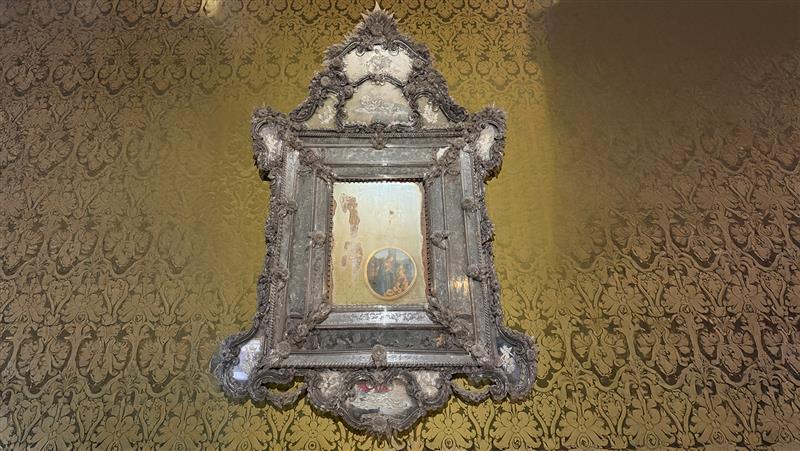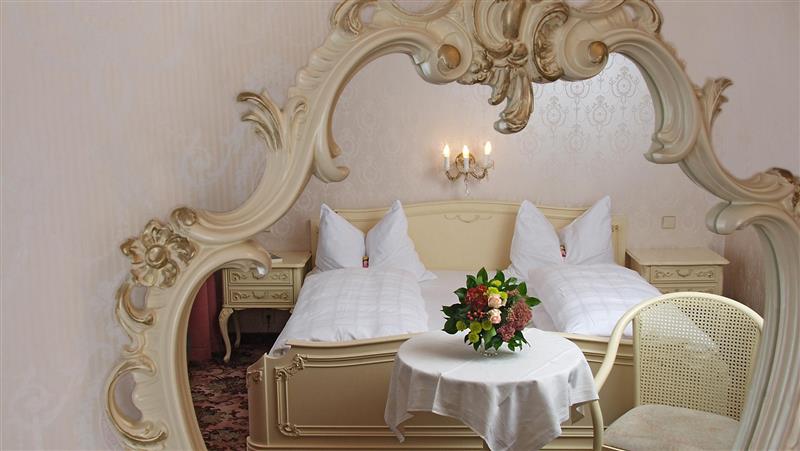Table of Contents
ToggleIntroduction
The history of Venetian mirrors is rich and goes back hundreds of years. These mirrors have influenced the decor of homes and palaces throughout many different periods of time. They are renowned for their detailed designs and excellent craftsmanship, and, as they are handmade and expensive, have become symbols of luxury and sophistication.
Brief History of Mirrors Before Venice
The earliest records of mirrors date to 1st-century Egypt. They were, however, only small handheld mirrors, not the wall mirrors that Venice later produced. They were generally metallic disks, usually made from bronze, although some were copper and even silver. They had ornate handles, such as shapes of female figures, gods or goddesses, or columns. These mirrors were expensive to produce, so they were only owned by royalty and the upper classes. In the tombs of the rich, there are murals showing people using mirrors.
The mirrors of Ancient Egypt were thought to be symbols of regeneration and were connected to the sun god, Ra.
The Romans were the first to use glass to produce mirrors. They coated blown glass with molten lead, but their production was limited, and there is little evidence that mirrors were used extensively for hundreds of years after the Roman Empire collapsed..
There was some progress in mirror production in the 12th century in Lorraine and Germany. Glass was metalized with lead or tin, but large mirrors still weren’t being produced.
The Rise of Venetian Mirrors
The Earliest Venetian Mirrors
The Venetians began making glass mirrors in 1318, but it wasn’t until 1369 that some success was achieved. The mirrors took a great deal of skill to produce, so only the wealthy could afford them. However, they were far from perfect, and it was in the following century that the superb Venetian mirrors we know today were created.
Angelo Barovier Invents Cristallo Glass
In the mid-15th century, Angelo Barovier invented a glassmaking technique called Cristallo, which turned out to be perfect for mirrors. It is a clear glass without the slightly yellow or greenish color produced by the iron oxide impurities that are created when other types of glass are being made. This clarity is achieved by adding manganese oxide to the glass mixture. The result is a transparent and colorless glass.
To create this glass, Barovier mixed quartz powder with plant material from the Mediterranean. He then added manganese dioxide, which had been used in glassmaking since the 1290s as a bleaching agent. The exact recipe was kept as a closely-guarded secret. To disclose it to anyone outside Venice was punishable by death.

The newly acquired ability of Venetian glassmakers to produce a clear polished glass surface without flaws made Venetian mirrors much in demand throughout Europe.
It is important to note that cristallo glass is not the same as crystal. Crystal is made with lead oxide, calcium, and potassium, and is heavier than Cristallo glass. It is also cut and polished by machines, unlike cristallo, which is handmade.
Venetian Mirrors During the Renaissance and Baroque
Mirror production in Venice significantly increased during the Renaissance and Baroque periods. In 1540, glass artisan Vincenzo Rector perfected a leveling and shining process that produced completely flat mirror surfaces.
Corporations were formed in Venice, which included mirror makers who developed new techniques. By the end of the 16th century, diamond-point engraving had become common in Murano mirrors, while the following century brought in highly decorative mirrors. Artisans, such as Giuseppe Briati, introduced elaborate decorative elements that were used both in chandeliers and in mirrors. They included colorful or gold-lined glass flowers and leaves. Wooden frames were varnished and painted gold, and the glass was decorated with oil paints.
As Venetian mirrors were created by hand, they were costly and could only be found in palaces and wealthy homes. What made them particularly special was the way they reflected light, making rooms seem bigger.
The Baroque period brought in even more opulent Venetian mirrors. The designs became elaborate, with dramatic curves and swirls. The mirrors were made to intensify candlelight, which in turn created stunning visual effects.
Bans were still in place forbidding Murano glassmakers from leaving the island, so that their secret techniques weren’t divulged, but some artisans did manage to leave. They brought glassmaking and, in particular, the production of Venetian mirrors, to countries such as Spain, Germany, England, Belgium, Denmark, Holland, and France. Louis XIV of France was envious of Venetian craftsmanship and went out of his way to recruit Murano artisans. Gerolamo Barbin was one of these artisans, and he decorated the magnificent Hall of Mirrors at Versailles.
To stop glassmakers from leaving, the authorities of the Venetian Republic decided to offer them privileges along with the punishments. They created a Golden Book with the names of the wealthy and influential merchants and nobles, and started to include the best glassmakers in the book. Thus, in 1658, the famous Barbini glass-making family, whose offspring was Alfredo Barbini, was registered in the book.
The Venetian Republic was dissolved by Napoleon Bonaparte in 1797, glass production declined, and with it, the creation of Venetian mirrors. However, this was not the end, and the mirrors would eventually be revived.
Venetian Mirrors In the 20th Century And Beyond
In the second part of the 20th century, Antonio Salviati, a famous glassmaker, revived artistic glass, and production on the island of Murano started to grow again.
In the 1900s, Nicolo Barbini worked with an elite group of other artisans to save Venetian mirrors. Still beautifully handcrafted, they became popular once again.
Today, contemporary artists use traditional techniques to create stunning Venetian mirrors, integrating modern designs into their handiwork. They pay respect to the work produced in the past, while making their work more accessible to the general public.
How to Identify Authentic Venetian Mirrors
- Glass quality – authentic Venetian mirrors have clear glass with no bubbles or distortions.
- Hand-etched designs – hand-engraved frames with intricate detailing and symmetry.
- Murano glass touches – look at the frames, and if there are small glass flowers, it is likely to be Venetian, as they are difficult to copy.
- The weight – Venetian mirrors are heavy because the glass is solid and the mirrors have a metal backing.
- Age – if you are looking to buy an antique Venetian mirror, there may be a little tarnishing on the backing, but the rest should be in perfect condition.
- Documentation and markings – Most authentic Venetian mirrors come with documentation of authenticity. Some have also been signed by the artist, though this is not always the case.
Why Venetian Mirrors Remain Popular
Artistic Appeal
Each Venetian mirror has been made with precision and superb craftsmanship. No two mirrors are identical.
Venetian mirrors enhance any room and decor, suiting both modern and classic designs. They complement both an up-to-date apartment and a traditional cottage. Because of this versatility, they are extremely popular.
Venetian mirrors have a unique ability to refract light, making the room they are in look bigger. If they are placed tactually, they can make a dark corner seem full of light.
These mirrors are sophisticated, elegant, and timeless, remaining in fashion throughout changing art movements. They are timeless and will last a lifetime.
Design Elements
The detailed patterns on the frames draw people to Venetian mirrors. Scrollwork and floral patterns are popular and give the mirrors a timeless elegance.
While classic Venetian mirrors remain very much in favor, modern mirrors in a variety of trendy colors are adding vibrancy to a space. Among these, green Venetian mirrors stand out as they have a fresh, tranquil vibe. Their hand-crafted frames are usually embellished with detailed designs, which your guests will admire. They complement both traditional and modern decor, making them versatile.
Gold Venetian mirrors are both sophisticated and extravagant. Their gilded frames with intricate carvings enhance the elegance of any space.
Unmatched Quality
Since the 15th century, Venetian mirrors have been associated with status. Historically, it was the nobility and royalty who owned these mirrors. Although they are available to more people these days, they are still made with the same precision and artistry now as they were 500 years ago. They still elevate a room, adding sophistication and style.
Valuable
Venetian mirrors are not cheap, but they are a good investment as their value appreciates. Although you may want to buy a contemporary mirror, antique Venetian mirrors are still highly sought after.
Slightly Mysterious.
The island of Murano is shrouded in both mystery and allure. The fact that the glassmakers weren’t allowed to leave the island makes us wonder what their lives really were like. Although they were given privileges for staying there, what would it have been like to be confined to such a small island?
Cultural Significance
Venetian mirrors are rooted in Italian culture, representing wealth, power, and a long history. They are a reflection of both the artistry and tradition of the Venetian artisans who created them. Displaying a Venetian mirror in your home showcases the cultural history of Venice. It isn’t hard to imagine the nobility and royalty through the centuries exhibiting their mirrors for all to admire. Venetian mirrors have, over the years, inspired artists and designers who have been captivated by them. Today, they continue to enthral and influence the arts.
Conclusion
The history of Venetian mirrors is rich and exciting. First created six centuries ago, they are still crafted by hand and decorate the homes of people who value artistic furniture and accessories. Once only available to the extremely wealthy, they are now more accessible, but they still symbolize luxury and sophistication.





